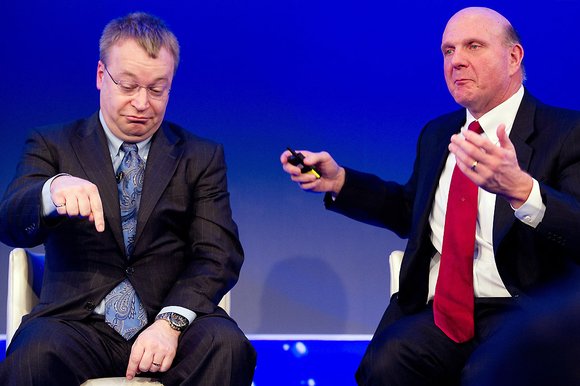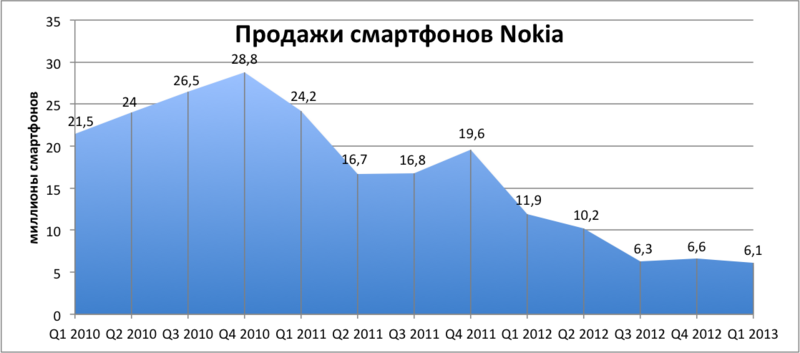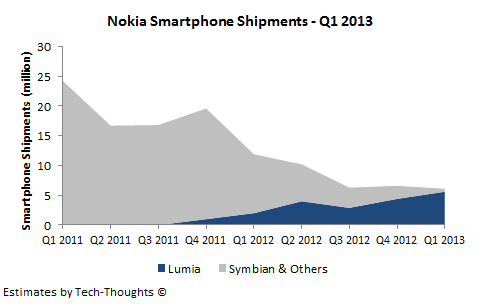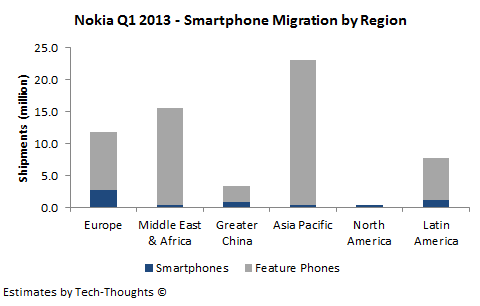Nokia: quarterly results
On April 18, Nokia released (a few hours late) a report for the first quarter. The results, of course, were predictable, but it seems to me worth stopping their attention. Therefore, I prepared a brief overview of the situation for those who may be interested in this topic.

Let's start, perhaps, with an updated version of my own charts, based solely on data from reports:


I took data from 2010 to the present moment, because in earlier reports there was no information on profit from smartphones. If you wish, you can look at the data in a convenient form since 2004 in my table and build your own graphs. You can also look at charts for a longer period in thispublication.
This will be followed by a hodgepodge of translation, other people's schedules ( from here and here ) and my explanations and additions.
Smartphone sales fell by 8% and now amount to 6.1 million (I note that this is not such a bad result, because in the fourth quarter there are always the largest sales). The estimated market share at the moment is 3% (32% at the time Elop joined Nokia). The smartphone division, which almost went to zero in the last quarter, again brings significant losses. ASP (average selling price) of a smartphone increased from 186 to 191 euros, while ASP specifically Lumia fell from 192 to 182 euros due to an aggressive pricing policy. Yes, at the moment, the average Symbian smartphone is one and a half times more expensive (292 euros) than the average Lumia:

The transition from Symbian to Windows Phone is almost complete. Nevertheless, the growth rate of the number of Lumia customers is still lower than the decline in the number of smartphone buyers on Symbian, which leads to a general drop in sales:

Territorial statistics also show a drop in most regions. Where sales of Nokia smartphones have increased (China, first of all, growth to 1 million units), they still remain insignificant against the background of the overall market size:

Sales of regular phones fell catastrophically. The fall was 30% (from 79.6 to 55.8 million units) for the quarter, specifically the Asha series fell by 45%, being supplanted by cheap Android smartphones. ASP phone fell from 31 to 28 euros. Perhaps the collapse of phone sales at the moment for Nokia is even more significant than the stagnant smartphone sales.

The situation is aggravated by the fact that at Nokia the percentage of smartphones in total sales is much lower than the market average:

In general, the picture is extremely sad. The fall in sales of conventional phones is finally knocking the ground out of Nokia's footprint as a mobile communications company. Smartphone sales in North America, the key market for Nokia since the arrival of Elop, fell 45% to 400 thousand. Before Elop, the company sold a total of 2.6 million phones and smartphones in North America. The company is again unprofitable (recall, the last quarter was the only one ended without loss after the first quarter of 2011, and specifically smartphones were unprofitable after the same quarter continuously).
For more complete data, I recommend reading the Nokia report , the publications of Tomi Ahonen and Samir Singh . If you haven’t gotten sick yetI’m interested in the history of Nokia and how the company has reached its current position, I dare to recommend its own publications, the first of which is a free translation / compendium of several publications by Ahonen, the second is exclusively hand-written analysis of Nokia official reports . I can also recommend reading this publication, which substantiates the point of view on Stephen Elop as the savior of Nokia - even if it contradicts the facts, it is written in a much more lively and beautiful language than my dry calculations; I assure you, you will enjoy reading. And, of course, good comments on all the publications mentioned, revealing and developing their subjects.
His firstI started the article about the role of Stephen Elop in the fate of Nokia with a question. I do not know if this article is the last, but just in case, I prefer to finish it with a question.
Tell me, do you believe in miracles?

Let's start, perhaps, with an updated version of my own charts, based solely on data from reports:


I took data from 2010 to the present moment, because in earlier reports there was no information on profit from smartphones. If you wish, you can look at the data in a convenient form since 2004 in my table and build your own graphs. You can also look at charts for a longer period in thispublication.
This will be followed by a hodgepodge of translation, other people's schedules ( from here and here ) and my explanations and additions.
Smartphone sales fell by 8% and now amount to 6.1 million (I note that this is not such a bad result, because in the fourth quarter there are always the largest sales). The estimated market share at the moment is 3% (32% at the time Elop joined Nokia). The smartphone division, which almost went to zero in the last quarter, again brings significant losses. ASP (average selling price) of a smartphone increased from 186 to 191 euros, while ASP specifically Lumia fell from 192 to 182 euros due to an aggressive pricing policy. Yes, at the moment, the average Symbian smartphone is one and a half times more expensive (292 euros) than the average Lumia:

The transition from Symbian to Windows Phone is almost complete. Nevertheless, the growth rate of the number of Lumia customers is still lower than the decline in the number of smartphone buyers on Symbian, which leads to a general drop in sales:

Territorial statistics also show a drop in most regions. Where sales of Nokia smartphones have increased (China, first of all, growth to 1 million units), they still remain insignificant against the background of the overall market size:

Sales of regular phones fell catastrophically. The fall was 30% (from 79.6 to 55.8 million units) for the quarter, specifically the Asha series fell by 45%, being supplanted by cheap Android smartphones. ASP phone fell from 31 to 28 euros. Perhaps the collapse of phone sales at the moment for Nokia is even more significant than the stagnant smartphone sales.

The situation is aggravated by the fact that at Nokia the percentage of smartphones in total sales is much lower than the market average:

In general, the picture is extremely sad. The fall in sales of conventional phones is finally knocking the ground out of Nokia's footprint as a mobile communications company. Smartphone sales in North America, the key market for Nokia since the arrival of Elop, fell 45% to 400 thousand. Before Elop, the company sold a total of 2.6 million phones and smartphones in North America. The company is again unprofitable (recall, the last quarter was the only one ended without loss after the first quarter of 2011, and specifically smartphones were unprofitable after the same quarter continuously).
For more complete data, I recommend reading the Nokia report , the publications of Tomi Ahonen and Samir Singh . If you have
His firstI started the article about the role of Stephen Elop in the fate of Nokia with a question. I do not know if this article is the last, but just in case, I prefer to finish it with a question.
Tell me, do you believe in miracles?
